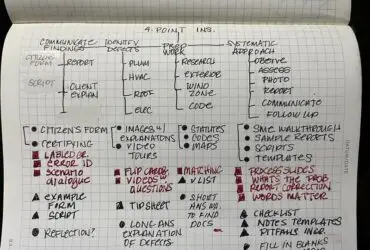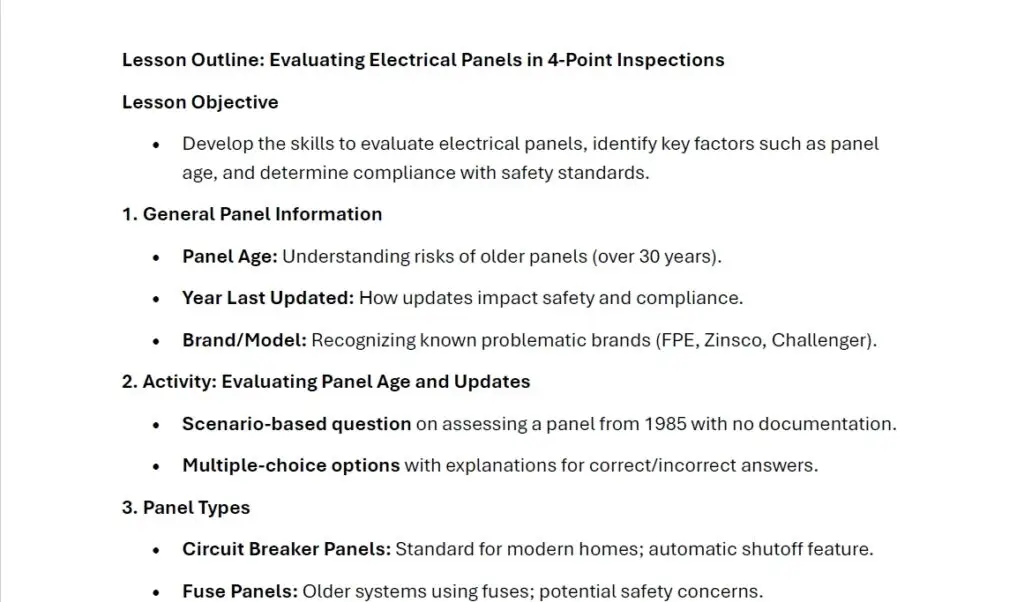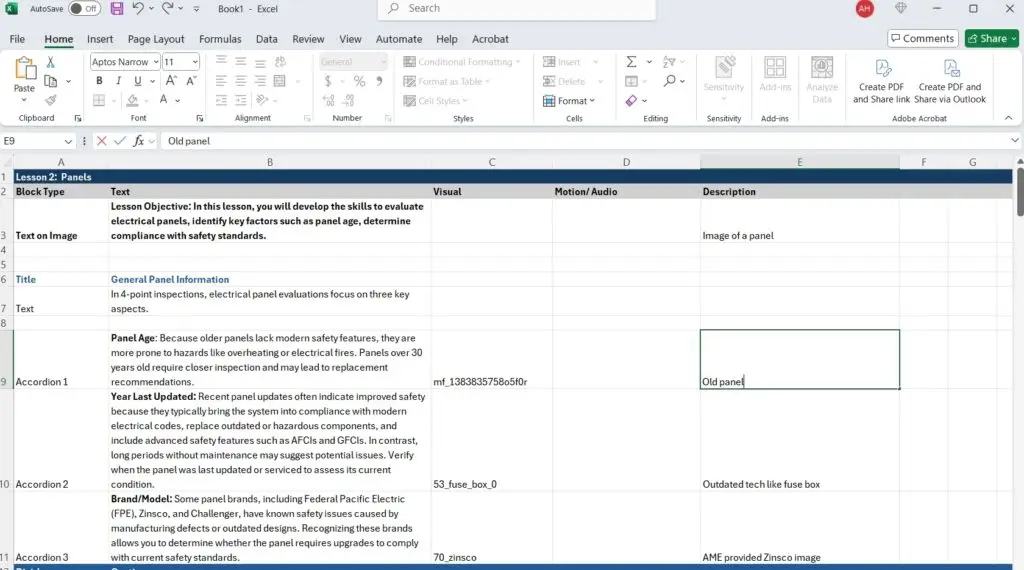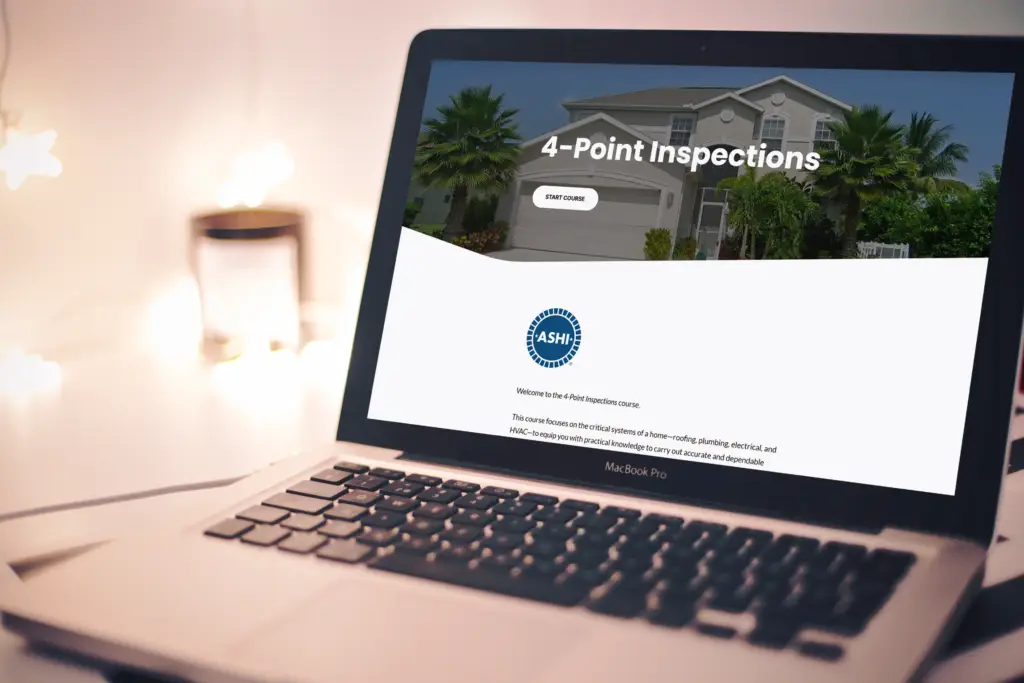
4-Point Inspection eCourse for Home Inspectors
Defining the Problem and the Approach
Leadership received multiple member requests for a 4-Point Inspection course. To address this need, I met with a Subject Matter Expert (SME) to fully understand the 4-Point Inspection process and pinpoint the minimum knowledge and skills inspectors needed to conduct these inspections correctly. The SME also shared anecdotes about common pitfalls—like missed or misreported data—and how to avoid them. We used these insights to craft the course’s learning objectives.
Since most interested inspectors were located in Florida—and the course was relatively short—hosting an in-person class in Chicago (or arranging lengthy travel within Florida) wasn’t practical. An eCourse made the most sense. It offered a flexible way to reach everyone—no flights or long drives required—and gave us the freedom to design more engaging assessments.
Watch the video below to understand how we determined the best modality for this course.
Drafting the Blueprint
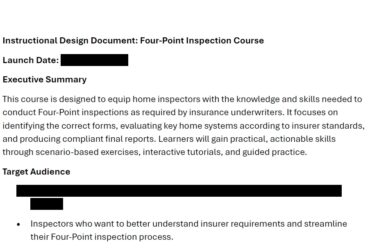
Next, I created and presented an Instructional Design Document (IDD) that outlined the course goals, design approach, and development timeline. Leadership reviewed and approved the IDD, which set the foundation for the next steps.
Task Mapping
With the IDD approved, my next step was task mapping—focusing on what inspectors needed to do rather than merely know. I broke down the entire 4-Point Inspection into individual tasks, identified the skills needed for each task, and planned activities to present, practice, and assess those skills.
Curriculum Design
I began by restructuring a lengthy SME-provided PowerPoint into a streamlined outline, creating a clear blueprint for the course. Since the course fulfills CE requirements, I prioritized assessment design early in the process. I created a summative assessment consisting of multiple-choice, true/false, and select-all questions. Additionally, I integrated formative activities such as interactive flip cards and scenario-based questions to reinforce learning.
Developing assessments first helped determine the necessary media and visuals while allowing for early SME and Director of Education feedback. Once assessments were in place, I designed engaging instructional content using multimedia, interactive elements, and scenario-based learning to ensure a dynamic experience.
An iterative review process, including SME input and pilot testing, refined the final course, ensuring effectiveness and alignment with learning objectives.
Storyboarding
With a clear content outline and assessment plan in place, I created a text-based storyboard in Excel. To consolidate text, block types, interactions, and media into a single document, I included the following
- Listed all text, interactions, and media for each screen.
- Downloaded existing images from the SME’s PowerPoint, labeled them, and logged them in the storyboard.
- Noted any new media that needed to be created or edited (e.g., graphics, videos) and added these items to a future sprint backlog.
- Incorporated learning activities (identified in the task map) to ensure each skill was supported and practiced.
Development
Effective multimedia enhances engagement and reinforces learning by providing diverse ways to interact with content. My development approach balances instructional effectiveness with user experience.
I allocated one sprint specifically for multimedia production. This phase included:
- Sourcing Stock Images: Ensuring legal and quality standards.
- Editing SME Images: Adhering to copyright considerations.
- Creating Videos: Often from PowerPoint slides with AI voiceovers.
- Designing Job Aids and Infographics: Workbooks, downloadable PDFs, or tip sheets for future reference.
Following the storyboard closely, I built the course in Articulate Rise, adding interactions, videos, quizzes, and text blocks exactly as planned.
Iterative testing ensured a smooth and engaging learning experience.
Results & Takeaways
1.
Scenario-Based Learning Works: Incorporating scenarios into both formative and summative assessments helped learners apply real-world inspection skills within the course environment. Feedback from inspectors suggested they felt more confident about conducting accurate 4-Point Inspections.
2.
Always Clarify Copyright and Approvals: I learned the hard way that SMEs may not fully understand copyright restrictions. I had to redo a video after discovering the narrative and imagery needed further approval. Going forward, I’ll secure sign-off on all media and scripts before production.
3.
Leadership Satisfaction: The Director of Education was pleased with the scenario-driven approach and the overall quality of the materials. The course fulfilled the CE requirements while remaining engaging and accessible.
4.
Task Mapping is Indispensable: Defining tasks, skills, and the corresponding activities proved critical for clarity and ensured every element of the course directly supported the learning objectives.
Conclusion
Developing this 4-Point Inspection eCourse showcased the power of a well-structured instructional design process. By focusing on tasks and skills, integrating varied assessments, and carefully storyboarding content, we delivered an engaging, compliant course that meets the needs of inspectors across Florida. Moreover, the lessons learned—particularly around approvals and copyright—will guide more efficient and legally sound development on future projects.

